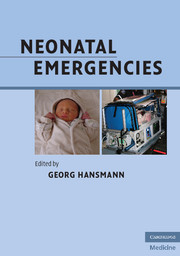Book contents
- Frontmatter
- Contents
- List of contributors
- Foreword (1)
- Foreword (2)
- Preface
- Acknowledgments
- Section 1 Organization of neonatal transport
- Section 2 Basics in cardiopulmonary resuscitation of newborn infants
- Section 3 Classic and rare scenarios in the neonatal period
- Management of healthy, term newborn infants (vaginal delivery, cesarean section, vacuum extraction, forceps delivery)
- Management of preterm and moderately depressed term newborn infants with a birth weight ≥1500 g
- Management of very preterm newborn infants (VLBW, ELBW)
- Twin–twin (feto–fetal) transfusion syndrome
- An apparently trivial call from the term baby nursery
- Out of hospital birth
- Hypoglycemia
- Meconium aspiration
- Chorioamnionitis and early-onset sepsis in the newborn infant
- Perinatal hemorrhage
- Perinatal hypoxia-ischemia
- Cerebral seizures
- Infants born to mothers on psychoactive substances
- Prenatal and postnatal arrhythmias
- Critical congenital cardiovascular defects
- Patent ductus arteriosus of the preterm infant
- Persistent pulmonary hypertension of the newborn (PPHN)
- Congenital diaphragmatic hernia
- Pneumothorax
- Congenital cystic adenomatoid malformation of the lung (CAM, CCAM)
- Chylothorax
- Hemolytic disease of the newborn
- Hydrops fetalis
- Choanal atresia
- Esophageal atresia
- Gastrointestinal obstruction
- Necrotizing enterocolitis (NEC)
- Omphalocele and gastroschisis
- Neural tube defects
- Cleft palate
- Birth trauma: brachial plexus palsy, facial nerve palsy, clavicular fracture, skull fracture, intracranial and subperiosteal hemorrhage (cephalohematoma)
- Sudden infant death syndrome (SIDS)
- Questions for review
- References (Section 3)
- Section 4 Transport
- Section 5 Appendix
- Index
- Plate section
Congenital cystic adenomatoid malformation of the lung (CAM, CCAM)
from Section 3 - Classic and rare scenarios in the neonatal period
Published online by Cambridge University Press: 05 March 2012
- Frontmatter
- Contents
- List of contributors
- Foreword (1)
- Foreword (2)
- Preface
- Acknowledgments
- Section 1 Organization of neonatal transport
- Section 2 Basics in cardiopulmonary resuscitation of newborn infants
- Section 3 Classic and rare scenarios in the neonatal period
- Management of healthy, term newborn infants (vaginal delivery, cesarean section, vacuum extraction, forceps delivery)
- Management of preterm and moderately depressed term newborn infants with a birth weight ≥1500 g
- Management of very preterm newborn infants (VLBW, ELBW)
- Twin–twin (feto–fetal) transfusion syndrome
- An apparently trivial call from the term baby nursery
- Out of hospital birth
- Hypoglycemia
- Meconium aspiration
- Chorioamnionitis and early-onset sepsis in the newborn infant
- Perinatal hemorrhage
- Perinatal hypoxia-ischemia
- Cerebral seizures
- Infants born to mothers on psychoactive substances
- Prenatal and postnatal arrhythmias
- Critical congenital cardiovascular defects
- Patent ductus arteriosus of the preterm infant
- Persistent pulmonary hypertension of the newborn (PPHN)
- Congenital diaphragmatic hernia
- Pneumothorax
- Congenital cystic adenomatoid malformation of the lung (CAM, CCAM)
- Chylothorax
- Hemolytic disease of the newborn
- Hydrops fetalis
- Choanal atresia
- Esophageal atresia
- Gastrointestinal obstruction
- Necrotizing enterocolitis (NEC)
- Omphalocele and gastroschisis
- Neural tube defects
- Cleft palate
- Birth trauma: brachial plexus palsy, facial nerve palsy, clavicular fracture, skull fracture, intracranial and subperiosteal hemorrhage (cephalohematoma)
- Sudden infant death syndrome (SIDS)
- Questions for review
- References (Section 3)
- Section 4 Transport
- Section 5 Appendix
- Index
- Plate section
Summary
Syndrome
Cystic adenomatoid malformation of the lung (CAML)
Definition
CCAM is a pulmonary hamartoma of the lung resulting from excessive growth of the terminal bronchioli leading to alveolar growth arrest. The lesion tends to be unilateral. The hamartoma may contain air or liquid and is connected to the bronchial system. Blood supply comes from the pulmonary circulation. In up to 20% CCAM is associated with malformations such as congenital diaphragmatic hernia (CDH), hydrocephalus, malformation of the bones, kidney, and small intestines.
Epidemiology
Incidence approx. 1:30 000 (0.33/1000)
Pathophysiology
Compression of surrounding organs, heart failure, hydrops, and lung hypoplasia are possible
Possible decrease or increase of mass
Poor prognosis in CCAM with fetal hydrops and polyhydramnios
Prenatal diagnosis
Ultrasound: macrocystic (diameter >5 mm) and microcystic (diameter <5 mm) forms
Prenatal DDx
Sequestrated lung, tumour, CDH (see pp. 404–9), lobar pulmonary emphysema, bronchogenic cyst
! A congenital cystic adenomatoid malformation (CCAM) can be diagnosed prenatally. The expectant mother must be transferred to a tertiary perinatal center prior to delivery.
Prenatal therapy
Puncture of a macrocystic malformation may be required
In specific cases thoracoamniotic shunting may be considered
Prenatal surgical treatment is not yet established
Clinical presentation
(Tachy) dyspnea
Pallor/cyanosis
O2 requirement varies
Hydrops fetalis and PPHN are possible
Postnatal DDx
Without a prenatal diagnosis: RDS, pneumothorax, aspiration, CDH, pleural effusion
Diagnosis in the delivery room
Auscultation: faint breathing sounds on the affected side
Blood gas analysis and blood glucose, laboratory work-up, and if necessary blood culture
HIV/hepatitis serology, blood type and screen/cross
- Type
- Chapter
- Information
- Neonatal Emergencies , pp. 417 - 418Publisher: Cambridge University PressPrint publication year: 2009



